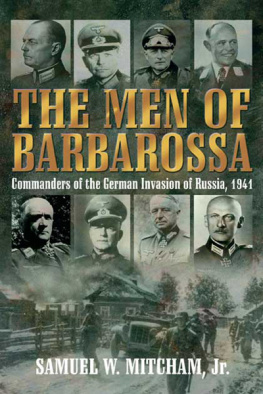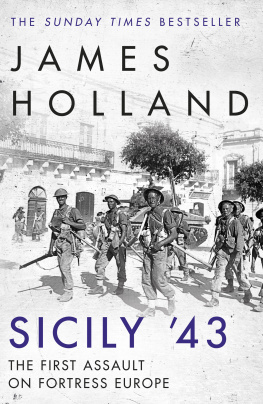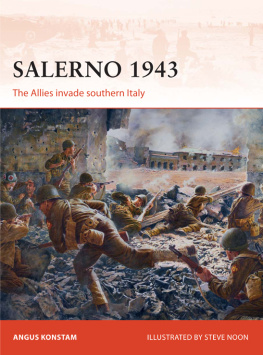THE BATTLE OF SICILY

Other titles in the Stackpole Military History Series
THE AMERICAN CIVIL WAR
Cavalry Raids of the Civil War
Picketts Charge
Witness to Gettysburg
WORLD WAR II
Armor Battles of the Waffen-SS, 194345
Army of the West
Australian Commandos
The B-24 in China
Backwater War
Beyond the Beachhead
The Brandenburger Commandos
The Brigade
Bringing the Thunder
Coast Watching in World War II
Colossal Cracks
D-Day to Berlin
Eagles of the Third Reich
Exit Rommel
Flying American Combat Aircraft of World War II
Fist from the Sky
Forging the Thunderbolt
Fortress France
The German Defeat in the East, 194445
German Order of Battle, Vols. 1, 2, and 3
Germanys Panzer Arm in World War II Grenadiers
Infantry Aces
Iron Arm
Luftwaffe Aces
Messerschmitts over Sicily
Michael Wittmann, Vols. 1 and 2
The Nazi Rocketeers
On the Canal
Packs On!
Panzer Aces
Panzer Aces II
The Panzer Legions
Retreat to the Reich
Rommels Desert War
The Savage Sky
A Soldier in the Cockpit
Stalins Keys to Victory
Surviving Bataan and Beyond
Tigers in the Mud
The 12th SS, Vols. 1 and 2
THE COLD WAR / VIETNAM
Flying American Combat Aircraft: The Cold War
Land with No Sun
Street without Joy
WARS OF THE MIDDLE EAST
Never-Ending Conflict
GENERAL MILITARY HISTORY
Carriers in Combat
Desert Battles
THE BATTLE OF
SICILY
How the Allies Lost Their Chance
for Total Victory
Samuel W. Mitcham, Jr.
Friedrich von Stauffenberg
STACKPOLE
BOOKS
Copyright 1991 by Samuel W. Mitcham, Jr., and the estate of Friedrich von Stauffenberg
Published in paperback in 2007 by
STACKPOLE BOOKS
5067 Ritter Road
Mechanicsburg, PA 17055
www.stackpolebooks.com
All rights reserved, including the right to reproduce this book or portions thereof in any form or by any means, electronic or mechanical, including photocopying, recording, or by any information storage and retrieval system, without permission in writing from the publisher. All inquiries should be addressed to Stackpole Books, 5067 Ritter Road, Mechanicsburg, PA 17055
Cover design by Tracy Patterson
Printed in the United States of America
10 9 8 7 6 5 4 3 2 1
Library of Congress Cataloging-in-Publication Data
Mitcham, Samuel W.
The battle of Sicily: how the Allies lost their chance for total victory / Samuel W.
Mitcham, Jr., Friedrich von Stauffenberg.
p. cm.(Stackpole military history series)
Originally published: New York: Orion Books, 1991.
Includes bibliographical references and index.
ISBN-13: 978-0-8117-3403-5
ISBN-10: 0-8117-3403-X
1. World War, 19391945CampaignsItalySicily. 2. Sicily (Italy)History
18701945. I. Stauffenberg, Friedrich von. II. Title.
D763.S5M58 2007
940.54'21548dc22
2007000835
eISBN: 9780811746694
Table of Contents
| vii |
| viii |
| ix |
| xi |
|
| Chapter 1 | |
| Chapter 2 | |
| Chapter 3 | |
| Chapter 4 | |
| Chapter 5 | |
| Chapter 6 | |
| Chapter 7 | |
| Chapter 8 | |
| Chapter 9 | |
| Chapter 10 | |
| Chapter 11 | |
| Chapter 12 | |
| Chapter 13 | |
| Chapter 14 | |
|
|
|
Appendix 2: Evolution and Titles of the
Hermann Goering Panzer Unit | |
Appendix 3: Order of Battle, Italian 6th Army,
July 10, 1943 | |
Appendix 4: Order of Battle, 15th Army Group,
July 10, 1943 | |
|
|
|
Maps
Tables
Introduction
T he Allied invasion of Sicily continues to provoke interest in the United States almost fifty years after it was fought. There are a number of reasons that this operation captures our imagination, including the heroics and histrionics of George Patton; the fact that it was our first amphibious invasion of the mainland of Europe and our first landing against German opposition; and because the American army came of age on the beaches and barren hillsides of Sicily, proving for the first in its own eyes and the eyes of the world that it was equal to the British army and worthy to be its full partner. The stain of Kasserine Pass was wiped out at Gela, Palermo, and especially Messina. Many Americans think that the German army took a severe beating in Sicily, and, when General Patton won the race for Messina, he permanently established the reputation of the U.S. Army as a force to be reckoned with.
Although Friedrich von Stauffenberg and I agree with a number of these points, we do not believe the German army was as badly damaged as Allied propagandists of the time indicated. Unfortunately, their lead has been followed by a number of historians. Our book takes a more balanced approach to this topic. We also take an opposing view on the subject of the race for Messina. This race (and I am uncomfortable calling it that) was not between Patton and Montgomery; rather, it was a three-party affair, and it was won by General Hans Valentin Hube, commander of the German XIVth Panzer Corps. For thirty-eight days his weak forces held off two full Allied armies. Their peak strength totaled well in excess of 400,000 men; Hube never commanded more than 65,000 Germans. In the end he pulled off a masterful evacuation and escaped to the mainland of Italy with his entire commanddespite unreliable allies, the fact that his rear was constantly exposed to enemy amphibious landings, and the fact that the Allies had complete supremacy of the air and sea and a six-to-one superiority on the ground. While Hube was accomplishing all this, Hitler was capturing Italy, a process that was incomplete when Hube finished evacuating Sicily but had gone so far by then that it was irreversible.
The purpose of this book is to tell the story of the Battle of Sicily primarily from the point of view of the Axis military commanders. Allied actions are normally covered only insofar as they affected the Axis situation or influenced Axis military reactions. Primary among these Allied actions was the decision to invade Sicily in the first placea strategic move which we hold to be fundamentally flawed. A more proper target would have been northwestern France or (if the landings had to come in the Mediterranean) the shores of Sardinia, which was less well defended and exposed more of Italy to a subsequent invasion. The Sicilian landings doomed the Allies to a prolonged battle of attrition up the bloody Italian peninsulahardly a brilliant stroke of military genius.










